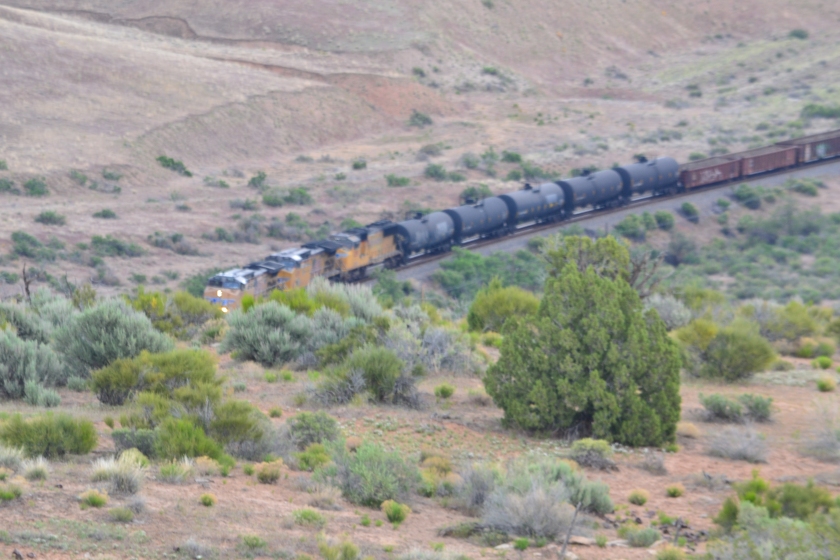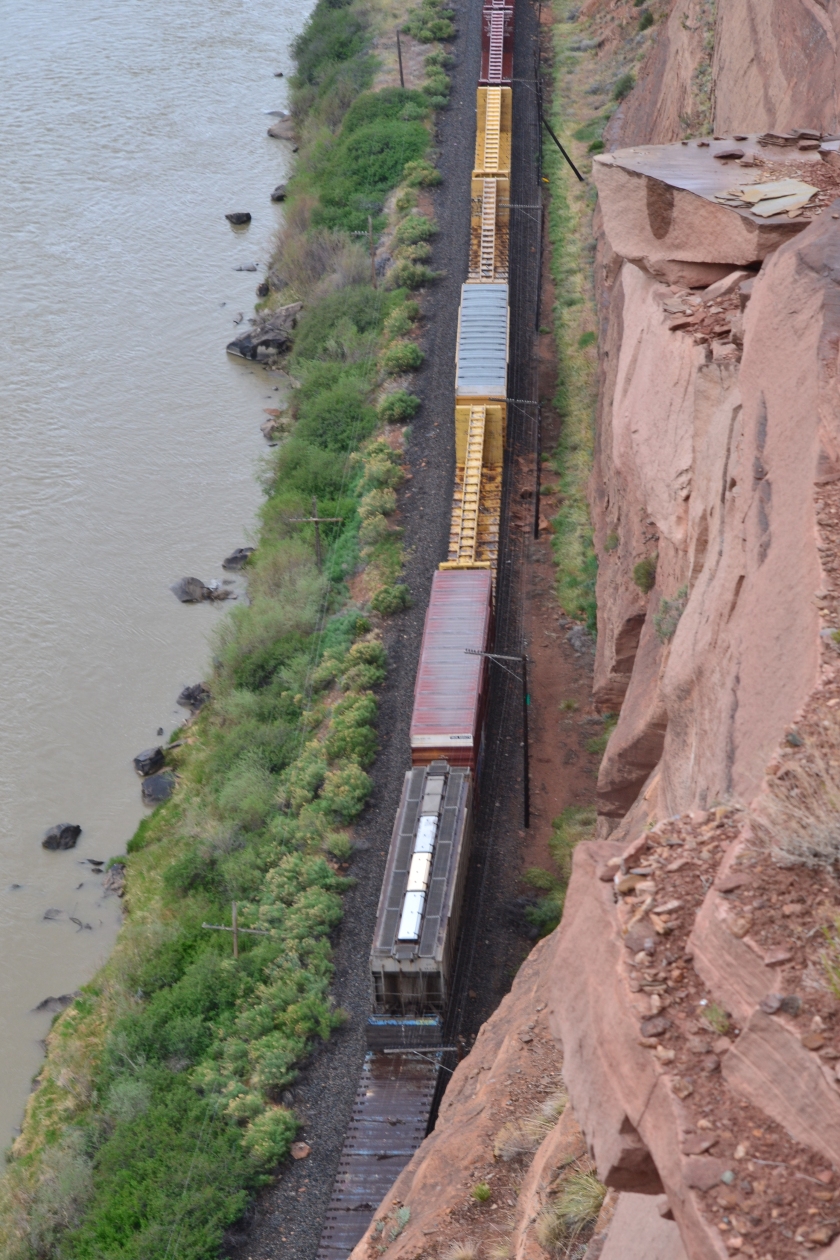So you think your job is tough.
Every now and again, one observes a situation that reminds us that the word work used to mean doing something physical. Over the first weekend of May 2017, we got to watch from on high as one such situation played out.
By way of background: I decided to “invite” the family out for a little near-wilderness camping in the BLM lands west of Grand Junction. In our case, this meant that I pulled our Hi-Lo camper trailer over six miles of ghastly roads to a remote campground overlooking the inner gorge of Ruby Canyon. Not coincidentally, the Union Pacific has a rail line down at the bottom, the former Rio Grande mainline. The spot where we parked the camper had a decent view of a stretch of track between McDonald Creek and the next curve to the east. This is about a mile or so east of the Utah/Colorado state line.
12:07 PM
On Saturday, I was out for a stroll when I heard the noise of a train coming down the canyon. Sprinting as fast as my out-of-shape 56-year-old legs would allow, I got back to camp in time to grab the telephoto and snatch an image of the front end just before it passed out of view. Not having time to get down to the actual rim (so I thought), I contented myself with snapping photos of the train from where I was.

12:09 PM
It was a westbound manifest freight– which simply means a mixed freight train, for those of you not into rail subjects. It was a long one, and after a while the rear end snaked into view with a single remote locomotive hanging on the back. (It totaled out to 120 cars, 3 locos up front, another on the rear.) I snapped a couple more photos and prepared to go about my business when suddenly I heard a lot of squealing and banging. The visible part of the train was decelerating rapidly, and within seconds was at a complete stop.
Well, to quote Jim Varney, I may not be a smart dog, but I know what roadkill is. Hurriedly hustling down the intervening benches, I soon found myself peering over the 300-foot precipice at a scene guaranteed to redefine the term “bad day at the office”. Directly below me the train was broken in two. 54 cars stretched out to my left and around the curve across McDonald Creek; the lone SD70ACe remote locomotive sat at the end, idling in a bored manner. To my right, the balance of the train reached all the way past the east switch of Utaline siding. In the middle was perhaps a quarter mile of empty rail.

By the way, the pictures illustrate that this is a fabulous location from which to observe a railroad problem! If the train had to break somewhere, this was the perfect spot for me. My luck was spectacular. On the other hand, for the crew it was about as bad a location as could be. Inside a tunnel might be a worse spot, but not by much. The luck of the guys managing the problem was, well, somewhat less than perfect.

Thankfully I had remembered to grab the scanner as I left camp, enabling me to garner the actual details of what followed. Before long I spied the conductor, a bearded fellow in a florescent yellow vest, walking back from the locomotives to check things out. He looked things over and called in a status report.
Conductor: “Yeah, it looks like the drawbar came out of one of the flatcars.”
Engineer: “Ah crap…”
They identified which car it was (UP 217030), then the engineer asked where the drawbar had gotten to. The conductor hiked back to the back half of the train and eventually located it, under the sixth car from the break. The cars had rolled over it as the train went into emergency after the air line parted.
For perspective, keep in mind that the drawbar is a 4-foot steel structure weighing a couple thousand pounds, with coupler attached. It was resting between the rails, perilously close to the southern (river-side) rail, and the conductor was not confident that the train could pass over it without snagging something important. They were actually lucky that it didn’t come down on an end and make the first car pole-vault over it. (** but, see update below, with photo **)
The engineer remarked that they were in a bad location for radio communications, but they finally managed to raise the dispatcher and explain the situation. Dispatch pointed out that Amtrak No. 5 was due from the east before long, but please take as long as they needed to work safely. Meanwhile the conductor tied down several cars on the broken section (i.e. set the handbrakes).
12:51 PM
Ultimately, they decided that they must set out the broken centerbeam flat in some siding to the west– I never heard which location was chosen but speculate it was Utaline siding. The conductor began his long march back to the head end, and we decided to go do something fun for a while. We hiked back to camp and drove out to take photos of flowers and lizards and dinosaur fossils. Meanwhile, based on visual evidence and conversations heard later on the scanner, the crew kept busy with the following:
- Moved off west to set out the broken car
- Returned to the scene of the crime (backing from wherever they went)
- Conductor walked back to the gap
- Decided to cut the train again and uncover the wreckage of the drawbar by pulling the cars off of it forward. Since it was under the sixth car from the break, they coupled on and cut the train again behind the sixth car, carefully moving forward until the drawbar was exposed.
5:23 PM
At about this point I returned to observe the doings. The engineer asked where the drawbar was, and the conductor replied, “Oh, it’s outside the rail now, toward the river.” The engineer sounded pretty surprised by this, as was I– I am still trying to figure out how he accomplished this feat. Perhaps he had a prybar back there and managed to lever it over the rail. I did see some other tools, so I suppose it’s possible. Regardless, once it was reported clear the engineer brought the train back and coupled on to the rear section.
Oh, and did I mention that it had been raining for a while now?



5:43 PM
So, after rejoining the train, they just throttled up and headed for Utah, right? Wrong. After this kind of event they have to perform a complete air check (i.e. air brake integrity and functionality) of the rear of the train. More conversations with dispatch about this; the engineer estimated another half hour to complete it. The conductor released all the handbrakes he’d set earlier and went off to inspect brakes, while I called it a night. An hour or so later I noticed that the train was gone.
** Update** See the photo below and its caption.

All throughout this process I kept wondering about the Amtrak train trapped behind this mess, and all the irritable passengers griping about the four-hour delay. I know it was weighing on the mind of the dispatcher, and I’m sure the train crew was brooding about it as well. But nobody from track maintenance ever showed up to help– indeed, how would they get there? There is no access road for some distance in either direction, and no hi-railers ever made an appearance. The train crew were basically on their own, which really meant that the conductor was on his own to do all the physical work.

. . .
Work. Ponder that concept. While most of us sit in our air-conditioned offices and do what we call work, there are those out there in the world who are still performing work in the very manual sense of the word. My hardhat’s off to them… 


good story and pictures. Thanks
LikeLike
With help and story from the crew, this would make a GREAT Trains story….
LikeLike
Thanks for a wonderful read!
LikeLike
Great piece Jim.
Not only modeller but I’ve always considered your dissertations excellent and poignant- whether factual or conjectural, you get the message across.
Dave W Akl NZ
(New home of the America’s Cup)
LikeLike